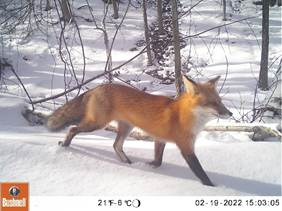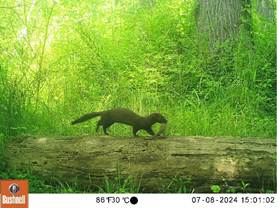Human development has historically resulted in the loss and fragmentation of natural areas and native species. In Ohio records indicate that the original populations of 15 native mammal species were extirpated by the early 1900s. Since its establishment in 1917, Cleveland Metroparks provides opportunities for human recreation and for park visitors to experience and enjoy wild places. Cleveland Metroparks’ property also provides crucial habitat for wildlife, and we have seen the return of at least 4 extirpated mammal species in our history.
-
To understand mammal species within Cleveland Metroparks a long-term urban wildlife monitoring project using over 200 fixed wildlife cameras was started in 2015. With the intent to not only survey wildlife but examine relationships with habitat and land management, wildlife cameras were deployed on Plant Community Assessment Program plots. The intent of this study is to understand the distribution and activity of wildlife throughout the park system. This includes studying relationships between wildlife species and with people and pets.


Images of a red fox and mink captured on wildlife cameras in Cleveland Metroparks
Our project is among the largest and longest running urban wildlife camera projects in the country. To date the project has resulted in over 650,000 days of continual wildlife monitoring and over 25 million images. Volunteer assistance allows us to maintain a project of this scale. Over 130 volunteers have contributed over 18,000 hours to the project to date.
Cleveland Metroparks Natural Resources staff and research collaborators use camera data to examine wildlife populations and relationships. This information contributes to the overall knowledge of our parks and helps facilitate ongoing management and conservation efforts. We are also examining this relative to landscape components and variables that represent urbanization and human effects on natural areas. Investigating human-wildlife interactions provides an opportunity to understand how people and wildlife use our parks and use this information to co-exist.
The project has resulted in numerous collaborative research projects and peer reviewed scientific publications. Cleveland Metroparks is an Urban Wildlife Information Network Partner, and our wildlife camera data contributes to national and international studies. According to ResearchGate (an online platform that connects over 20 million scientific researchers from around the world) our camera publications listed below have currently been cited over 300 times. Collectively, our monitoring and research efforts help to advance our understanding of urban ecology and ensure that Cleveland Metroparks are ecologically healthy refuges for both wildlife and people.
Research Publications (names in bold are current or past Cleveland Metroparks staff):
- Moll, R. J., J. D. Cepek, P. D. Lorch, P. M. Dennis, T. L. Robison, J. J. Millspaugh, and R. A. Montgomery. 2018. Humans and urban development mediate the sympatry of competing carnivores. Urban Ecosystems. https://doi.org/10.1007/s11252-018-0758-6
- Lepard, C. C., R. J. Moll, J. D. Cepek, P. D. Lorch, P. M. Dennis, T. L. Robison, and R. A. Montgomery. 2018. The influence of the delay period setting on camera trap data storage, wildlife detections, and occupancy models. Wildlife Research. https://doi.org/10.1071/WR17181
- Moll, R. J., J. D. Cepek, P. D. Lorch, P. M. Dennis, T. L. Robison, and R. A. Montgomery. 2019. At what spatial scale(s) do mammals respond to urbanization? Ecography. 42: 1–13, 2019. https://doi.org/10.1111/ecog.04762
- Moll, R. J., J. D. Cepek, P. D. Lorch, P. M. Dennis, E. Tans, T. L. Robison, J. J. Millspaugh, and R. A. Montgomery. 2019. What does urbanization actually mean? A framework for urban metrics in wildlife research. J Appl Ecol. 2019; 56:1289– 1300. https://doi.org/10.1111/1365-2664.13358
- Moll, R. J., W. Ortiz-Calo, J. D. Cepek, P. D. Lorch, P. M. Dennis, T. L. Robison, and R. A. Montgomery. 2020. The effect of camera-trap viewshed obstruction on wildlife detection: implications for inference. Wildlife Research 47, 158-165. https://doi.org/10.1071/WR19004
- Devarajan K., B. Gerber, M. Fidino et al. (including J. D. Cepek) 2025. When the wild things are: Defining mammalian diel activity and plasticity. Science advances. 11. eado3843. https://doi.org/10.1126/sciadv.ado3843
